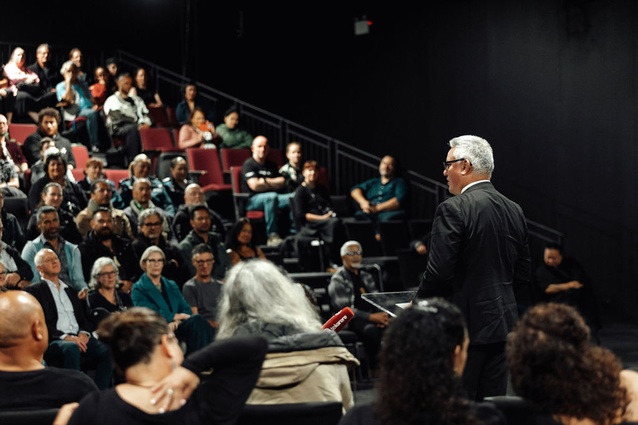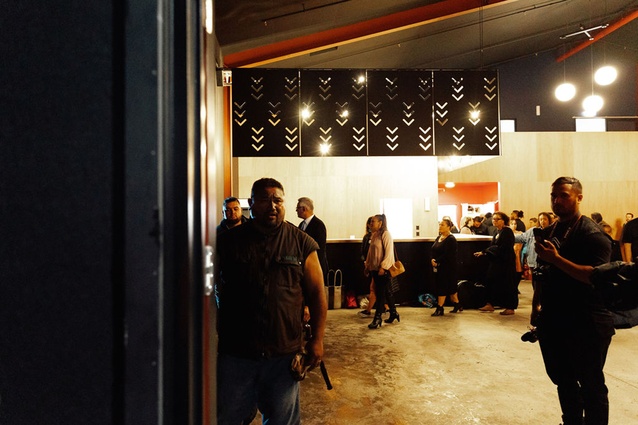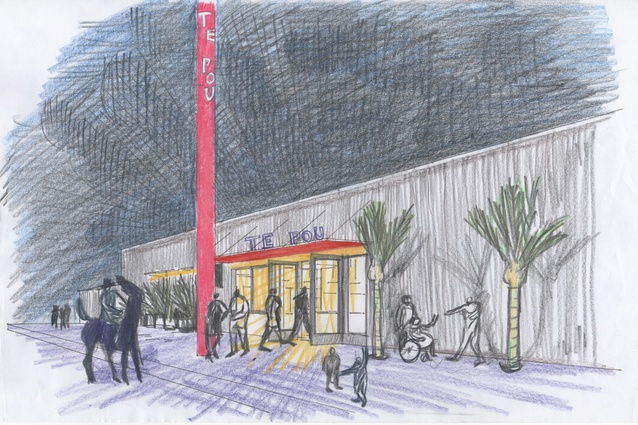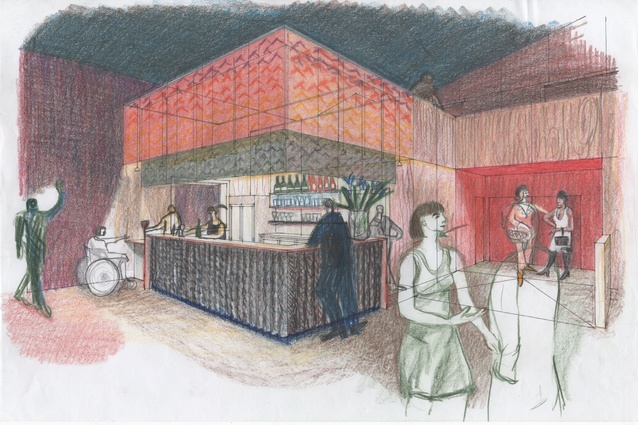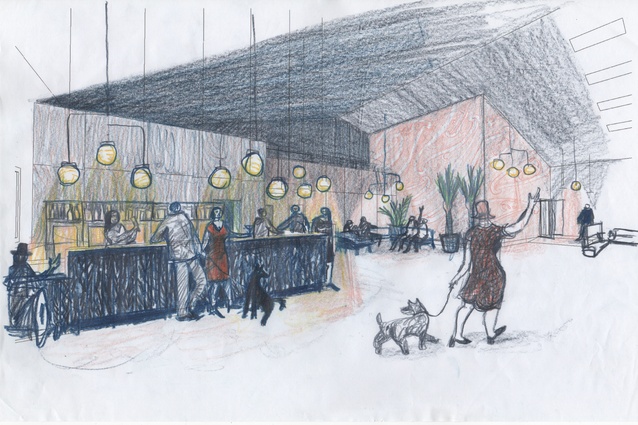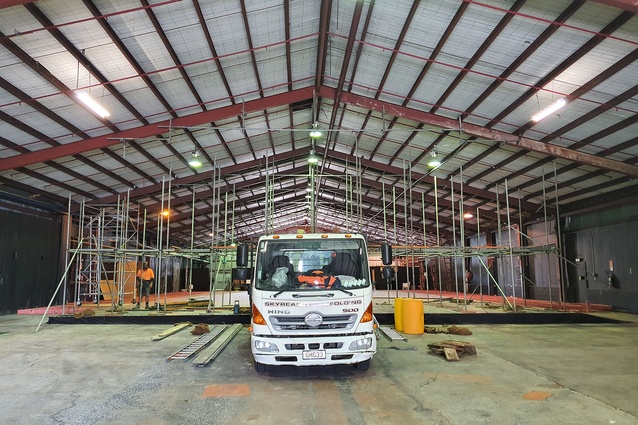From tin shed to contemporary theatre
Te Pou Theatre, the world's first independently owned indigenous theatre venue opens this month — the interior architecture with te ao Māori at its heart.
April 2015 represented a significant milestone within the Auckland arts community. In New Lynn, the first Auckland home for kaupapa Māori theatre was opened at 44a Portage Road. Te Pou Theatre, the first independently owned indigenous theatre venue in the world, had arrived on the arts scene.
Come 2018, Te Pou made the gutsy decision to move to Shed 1 at the Corban Estate Arts Centre, adapting it for use as a theatre with money sourced entirely from grants. This marked the beginning of one of the most important cultural arts projects in New Zealand. It attracted a very special group of architects, builders, designers and patrons of the arts, who supported its founding leaders Tainui Tukiwaho and Amber Curreen with an outpouring of generosity.

Through a tremendous fundraising effort over the next two years, they raised just over three million dollars for the new theatre — a massive $2.7 million of that fundraised solely by the theatre’s Kaihautū Taha Hinengaro Amanda Rees, who joined Te Pou in 2020 and who project-managed the build.
Through this initial appeal, they were able to start planning the design and build of the new theatre space, which was briefly opened to the public in 2021 before construction began.
The architect appointed for the interior fit-out was Graeme Burgess of Burgess, Treep & Knight Architects, who worked together with his colleague Wade Southgate to provide architectural design and consultancy services. The builder Chain Construction was known to the architects, and whose team led by James Delaney “showed incredible tenacity and dedication throughout the process,” says Burgess.
As fate would have it: Corban Estate connections
Burgess was first made aware of the theatre through his association with Naomi McCleary, a member of the Corban Estate Arts Centre board of which he was fomerly a member. “McCleary could be a candidate for the next face to go on a NZ$50 note,” joked Burgess, and it was due in large part to McCleary — a patron of the arts in West Auckland — that Te Pou received the green light to move to Corban Estate in the first place.
“He’s a Pākehā fella, but he has a strong heart for te ao Māori that’s enabled us to work in a way that brings our mātauranga Māori and our tikanga to them [Burgess Treep and Knight] as architects, without there being any kind of frisson or coming up against any difficulties.”
- Amber Curreen, Te Pou Theatre founding member, on Graeme Burgess, project architect.
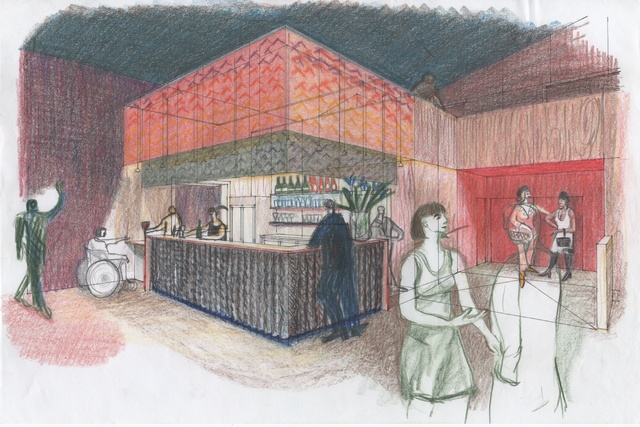
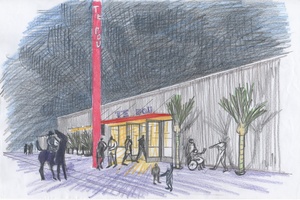
Burgess has been privileged to work on a number of Māori architecture projects in his career, which have deeply influenced him both personally and professionally.
This work includes restoration of the iconic Tūrangawaewae House in Ngāruawāhia, a listed heritage building that combined arts and crafts style with traditional Māori architecture, as well as a 12-year relationship restoring and extending Ōmanaia Marae in Hokianga, early work for Ngāti Maru, and later, Tainui.
The concept for Te Pou was presented in Burgess’s signature watercolour drawings — his designs reflecting the need for the space to accommodate powhiri and function like a marae atea and gateway, accomodating the traditional functions of a wharenui.
“One thing that’s interesting about it, is you don’t enter from the end like you would in a wharenui, so we had a few discussions around how you could create that feeling of welcoming, with the ability to hold powhiri, and whakatau.”
-Maia Ratana, Te Pou Theatre board member and Māori architecture specialist.
A Pākehā architect with a heart for te ao Māori
Burgess’s association with the Corban Estate Arts Centre board gave him an intimate knowledge of the site, but it was his respect for Te Pou’s kaupapa that impressed Curreen: “He’s a Pākehā fella, but he has a strong heart for te ao Māori that’s enabled us to work in a way that brings our mātauranga Māori and our tikanga to them [Burgess Treep and Knight] as architects, without there being any kind of frisson or coming up against any difficulties.”
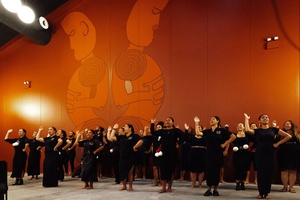
Although a kaupapa Māori-led architecture firm may have been the obvious choice from the outset, Burgess’s enthusiastic support — offering planning services and creative problem-solving — allowed Te Pou to find solutions to tight budget constraints and get the ball rolling on funding applications.
“We’re not a theatre that the Council built for artists to occupy,” explains Curreen. “We’re a theatre that theatre-makers created. So, in needing to keep costs down he [Burgess] came up with this idea of putting in prefabricated walls, and had other interesting and outrageous ideas for what we could do at a low cost.”
Interior architecture that functions for Māori
Maia Ratana, Te Pou Theatre board member and lecturer at Unitec School of Architecture teaching Māori Studio alongside Rau Hoskins, found the internal programming and layout of the building to be particularly interesting. “We talked a lot about how the building functions for Māori,” she says.
“One thing that’s interesting about it, is you don’t enter from the end like you would with a wharenui, so we had a few discussions around how you could create that feeling of welcoming, with the ability to hold powhiri, and whakatau.” When speaking on these traditional functions, Ratana stressed the importance of appropriate delineation between certain activities “…just thinking about things around tapu (sacred) and noa (ordinary), when designing spaces for Māori kaupapa.”
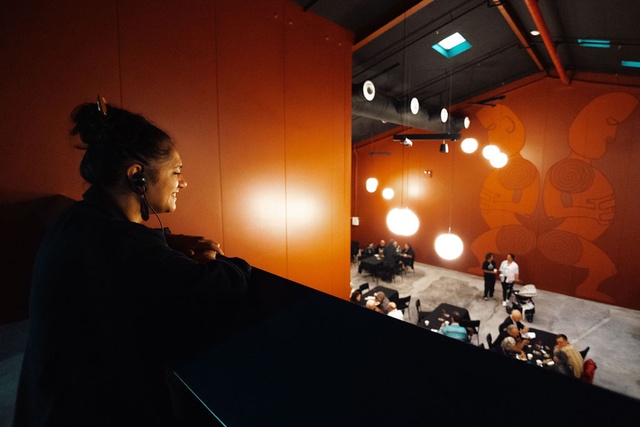
A big space — its retro-fitting, a tall order
The theatre is located in Shed 1, a plain 1970s gabled industrial shed at 24.5m wide by 69m long. Inside, the main theatre space is 32m x 23m with a very high ceiling, at 8.2m at the highest point. Hints to the shed’s past as a winemaking facility are everywhere — from the echoey bare-boned steel construction to the sloping of the concrete floor, which facilitated the washing away of liquid spillage. Due to the scale and materialisation of the existing structure, acoustics and lighting needed a great deal of consideration.

The first stage of the build was completed in 2020 with a 750m2 black box auditorium designed to seat 250, with insulation and acoustic wall panels, air conditioning, and lighting rig going in.
By the close of 2022, significant progress has been made: a 145m2 rehearsal space, offices, hui rooms, box office public amenities, and insulated foyer have been completed. This second stage also saw the installation of a mezzanine floor containing offices and hui rooms that overlook the main atea, or hub, of the theatre.
Twelve skylights were gifted to Te Pou by Velux NZ Limited. Nine of which have been positioned in the lobby ceiling in the shape of the Matariki constellation, creating a night-sky effect in the central hub of the theatre.
An important aspect of the renovation work according to Curreen was to “whakamana,” or empower, what was already there by designing around a pre-existing main stage that had hosted performances by Atamira Dance Company, Hawaiki TŪ, Red Leap and so many more.
“People had sweated onto that stage, they’d bled onto it and had poured all of their energy into that space. It’s been a stage that has held so much creativity over many, many years before we got there, so we wanted to build around that as opposed to tearing everything out of the way and starting again.”
-Amber Curreen, Te Pou Theatre founding member
“People had sweated onto that stage,” explains Cureen. “They’d bled onto it and had poured all of their energy into that space. It’s been a stage that has held so much creativity over many, many years before we got there, so we wanted to build around that as opposed to tearing everything out of the way and starting again.”
The new theatre’s wharepaku is one place where Burgess’s penchant for colour — as seen in the multi award-winning ‘Whare Koa, Māngere Community House’ — will be showcased. Different brightly coloured tiles feature in each toilet cubicle with its adjoining lobby finished in Brazilian tiles resembling tukutuku panelling.
The care and attention demonstrated in the finishing of this space, align with the theatre’s aim to convey a sense of manaakitanga to those that visit and support Te Pou and its whānau.
Not simply a built project, but a community
Burgess captures the resounding feeling from all those that have partaken in this exceptional project: “Te Pou is an amazing community, uplifting, full of energy and optimism. For us as architects, it is a privilege to work within a te ao Māori framework supporting the tikanga of Te Pou. We feel very lucky to have been part of this mahi rangatira. It is hugely rewarding to work with a community group on this kaupapa.”

Stage 3 is now underway and will see further acoustic buffering added to the theatre, design elements in the foyer and performance studios realised, all backstage facilities built and additional drainage and power supplies put in. Te Pou is planning to reopen to the public in February 2023 with its first show ‘Hemo is Home’ opening in March 2023.
“There are no Māori theatres period across Aotearoa, so this will be the first purpose-built theatre space for Māori performance. But what excites me is the potential of this building to bring people together in West Auckland — to create a hub for kaupapa Māori.”
-Maia Ratana, Te Pou Theatre board member and Māori architecture specialist.
When Te Pou opens its doors, it will be a theatre Aotearoa can be proud of as a world-first. The efforts of such a feat are not lost on the architectural community. Ratana sums it up: “…it was all fundraised — all the money — which is a huge effort. It’s really hard to build something Māori for one; it’s hard to get the funding stream. The amount of effort that’s gone into raising the funds is pretty impressive, I think.”
On the impact of the venue on the wider community, Ratana adds:
“There are no Māori theatres period across Aotearoa, so this will be the first purpose-built theatre space for Māori performance. But what excites me is the potential of this building to bring people together in West Auckland — to create a hub for kaupapa Māori.”
Te Pou Theatre - architect’s impression:
ArchitectureNow will follow up this article upon the opening of the theatre in late February 2023, with an image gallery of the completed theatre fit-out.
Te Pou’s new whare was made possible through significant support from Foundation North, Lottery Community Facilities, The Trusts Community Foundation, Chisholm Whitney, One Foundation, Stout, The Trusts, Four Winds, BlueSky, St Lazarus and Grassroots.
For more information on Te Pou Theatre, and to view upcoming events head to their website.



